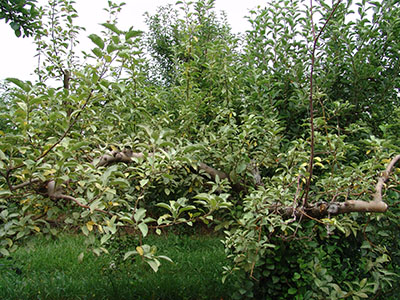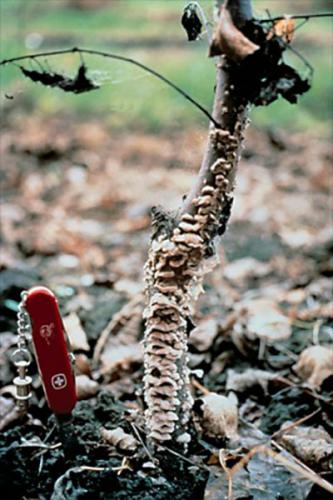Silver leaf of tree fruits
Silver leaf can cause tree fruit leaves to exhibit a dull metallic luster and can cause a slow decline in tree vigor and yield.

Biology
Silver leaf is present in most temperate zone production areas. While it can cause severe and destructive symptoms in some areas of the world, this is rarely the case in Michigan orchards. It is caused by the fungus Chondrostereum purpureum (Pers. Ex:Fr.) Pouzar. It occurs occasionally on isolated trees in sour cherry and apple orchards throughout the United States and Canada. It can also occur on plums, peaches and nectarines. It is of negligible economic importance and more of a curiosity when seen.
Symptoms and disease cycle
Leaves, usually on one or two branches per tree, exhibit a dull metallic luster. Affected leaves may also exhibit necrotic areas. These “silver leaves” are due to a separation of the upper epidermis from the palisade layer. Because of this separation, the upper epidermis can be peeled back easily.
The causal fungus is located in the wood of the trunk or branches below affected leaves. The fungus decays the wood and produces a toxin that induces the silvery condition when translocated to leaves. These silver leaves stand out against the healthy leaves (Photos 1 and 2).

Photo 2. Silver leaf symptoms on apple limbs.
The vigor of infected trees declines for several years before they die. Eventually, flat, grayish-brown fruiting bodies of C. purpureum may be observed on the bark of dead branches and trees (Photo 3). Basidiospores, produced in the fruiting bodies from autumn to early summer the following year, germinate and infect primarily through fresh wounds. Then, the fungus extends upward and downward from infected wounds.

Photo 3. Basidiocarps of C. pupureum on trunk of peach.
Management
Maintaining trees in good vigor, pruning off broken and dead limbs and training and pruning trees annually – thereby avoiding the need to make major pruning cuts later – all help to prevent infection and reduce disease spread. All infected prunings should be burned or buried. Michigan State University Extension advises trying to avoid pruning during wet periods where further infection can occur.
References
- Diseases of Tree Fruits in the East, A.L. Jones and T.B. Sutton
- Compendium of Stone Fruit Diseases, Pages 30-31, K.G. Tate



 Print
Print Email
Email




